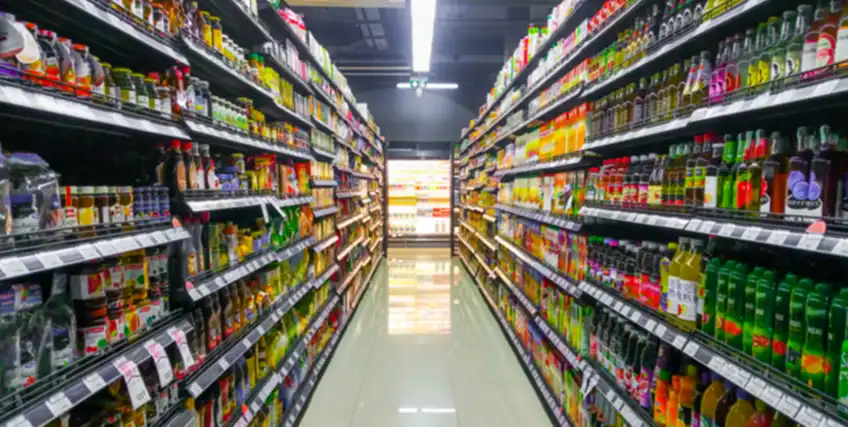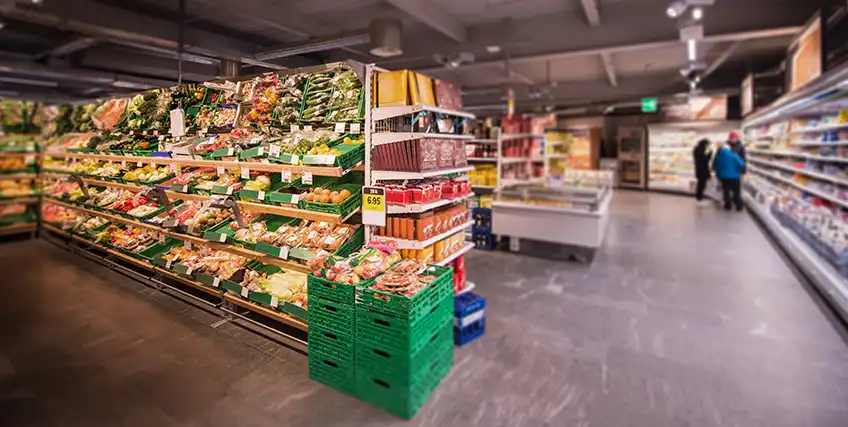Loans for Supermarkets: Fueling Growth in a Competitive Market
April 01, 2025 | Last Updated on: April 02, 2025

Supermarkets and grocery stores provide a valuable service by offering the local community fresh food, household items, and more. If you're an aspiring entrepreneur or an existing owner looking to grow, it is vital to secure affordable financing, especially within the fiercely competitive supermarket industry. Strategic investments are essential to maintaining a competitive edge and ensuring long-term sustainability. Learn more about loans for supermarkets, including the types of loans available, common uses of loan proceeds, and how to boost your credit score before applying.
Current State and Challenges of the Supermarket Industry
The supermarket industry faces constant change, creating opportunities and challenges for grocery store owners. According to IBISWorld, the supermarket industry was $873.4 billion in 2024. Higher competition places pressure on profit margins, even as the supply chain is still recovering from inventory disruptions due to COVID. This places even more importance on operational efficiency, affordable financing, and reliable profits.
- A growing industry: Industry growth continues, indicating a dynamic market with potential for expansion. Grocery store owners must incorporate strategic planning to capitalize on emerging opportunities and manage increased competition.
- Expanding market size: As the market expands, a larger pool of potential customers exists. Supermarkets must adapt their offerings and strategies to accommodate diverse and evolving consumer preferences.
- Online shopping: Trends include online ordering, reflecting the significant shift toward digital convenience. To meet the growing demand for online grocery services, investments in technology and infrastructure are required.
- Stressed profit margins: Competition stresses profit margins and demands careful financial management, especially when taking out loans for supermarkets. Focusing on operational efficiency allows you to maintain profitability in a market characterized by thin margins and intense rivalry.
- Disruptions to supply chain: Supply chain disruptions impact stock, causing inventory fluctuations and potential stockouts. Robust inventory management systems and flexible sourcing strategies can mitigate disruptions and improve sales.
Financial stability sustains operations, ensuring the ability to meet day-to-day expenses and weather economic fluctuations. Expansion demands capital, requiring access to external funding to invest in growth initiatives and capitalize on emerging opportunities. Do you have sufficient funds to meet current operational needs and growth aspirations? If not, will you need to compare loans for supermarkets to obtain the funds?
Strategic Uses for Loans for Supermarkets
Grocery store financing is similar to a loan application for any other type of business. However, supermarket profit margins tend to be much smaller than other types of companies. With an average profit margin of 1% to 3%, putting your loan amount to good use is crucial to ensure you receive a positive return on investment (ROI) for your capital.
New Locations and Upgrades to Existing Stores
Strategic uses exist for loans for supermarkets, with expansion and renovation topping the list. New locations provide growth opportunities, and existing stores gain upgrades that enhance the customer experience and improve operational efficiency.
- Invest in new store locations to allow for market penetration and increased customer reach. This requires thorough market analysis and demographic studies to identify viable locations with high growth potential.
- Upgrade existing facilities, enhancing customer experience and operational efficiency through renovations that improve store layout, lighting, and overall aesthetics, creating a more appealing shopping environment.
- Improve customer flow, ensuring efficient store layouts that minimize congestion and enhance the shopping experience, contributing to customer satisfaction and loyalty.
- Enhance store aesthetics, creating a pleasant and inviting environment that attracts and retains customers, requiring investments in interior design, lighting, and visual merchandising.
Managing Inventory
Inventory management requires funding to increase stock variety and quantity, meeting customer demand. Implementing inventory systems improves efficiency and reduces waste through optimized stock levels and forecasting. Technology and infrastructure demand investment in advanced point-of-sale (POS) systems, online platforms, and delivery services, enhancing operational efficiency and customer convenience.
- Increase stock variety, meeting diverse customer preferences by offering a wider selection of products, which requires careful analysis of customer demand and market trends.
- Implement inventory systems, optimize stock levels, and reduce waste through efficient inventory management systems that provide real-time data and forecasting capabilities.
- Adopt advanced POS systems, improving transaction speed and data analysis through modern systems that integrate with inventory management and customer loyalty programs.
- Enhance online platforms, expanding customer reach and sales channels through robust online platforms that offer seamless online ordering and delivery services.
- Improve delivery services, catering to customer convenience and expanding reach through efficient delivery services that meet the growing demand for online grocery shopping.
Attracting Customers to Your Stores
Marketing and branding drive foot traffic, requiring robust campaigns that attract customers and build brand awareness. Rebranding maintains relevance in a constantly evolving market.
- Develop marketing campaigns, increasing brand awareness and customer acquisition through effective campaigns that leverage various marketing channels and strategies.
- Rebrand for competitiveness, keeping the business relevant in a changing market through strategic rebranding initiatives that refresh the brand image and appeal to target audiences.
- Build customer loyalty, fostering customer retention through loyalty programs and personalized experiences that create strong customer relationships.
Types of Loans for Supermarkets
Several types of small business loans for grocery stores are available, and these business financing options include both short-term and long-term repayment. The money can be used for your grocery store business's working capital, equipment, expansion, and more. Before you get the money, supermarket business loans must be aligned with your needs and ability to repay. Here are a few loan options to consider.
- Conventional loans. Traditional bank term loans for supermarkets offer capital upfront with fixed monthly payments and interest rates to meet your business needs. You'll receive a lump sum of cash to invest in your business, but many lenders require a strong business plan and financial projections.
- Small Business Administration (SBA) Loans. SBA loans, including the SBA 504 and SBA 7(a), provide guarantees that allow banks to lend to borrowers who may not get approved for traditional loans. Small business loans may offer less stringent underwriting and lower interest rates through SBA guarantees to small businesses and startups. The SBA 504 loan program assists with fixed assets, funding the purchase of land or equipment through long-term, fixed-rate loans that support business growth and expansion.
- Equipment financing. Equipment financing funds loans and leases to purchase new equipment. The equipment secures these loans for supermarkets and allows flexibility based on the projected value of the item at the end of the loan term.
- Business line of credit. A business line of credit offers flexibility and low monthly payments. This working capital loan provides access to funds as needed through revolving credit lines replenishing as you pay down your balance. It offers a variable interest rate, and you'll pay interest charges based on how much you borrow each month.
Boosting Your Credit Before Applying for Loans for Supermarkets
It is important to boost your credit scores before applying for a loan. Your scores may impact eligibility and determine the loan terms offered by lenders. Both personal and business credit scores matter. As lenders evaluate business credit to assess risk, they require businesses to maintain a strong credit history and financial standing.
How to Improve Your Credit Score
Improve credit scores by paying bills on time, reducing debt, correcting errors on reports, and establishing a strong credit history. Building a strong financial profile proves essential through maintaining solid financial statements, managing cash flow effectively, and developing a strong business plan.
- On-time payments. Paying bills promptly demonstrates financial responsibility, which contributes to a positive credit history.
- Utilization ratio. Reduce debt, improve credit utilization and financial stability through lowering debt levels and managing credit responsibly.
- Correct report errors. Before applying for loans for supermarkets, correct credit report errors by ensuring accurate information. Studies have found that 1 in 4 people have errors that could impact their credit score.
- Average age of credit. Establish a solid credit history by building trust with lenders. Keeping accounts open for long periods and managing them responsibly demonstrates financial reliability.
Prepare Your Business Financials
Accurate financial statements present a clear picture of the business's financial health, while lenders examine cash flow to assess the ability to repay loans. Business plans demonstrate strategy and financial projections, providing a comprehensive overview of the business's vision and goals.
- Maintain solid financial statements: Showcase your financial health through accurate and up-to-date financial statements that provide a clear picture of business performance.
- Positive cash flow: Demonstrating financial stability through effective cash flow management that ensures liquidity and meets operational needs.
- Write a business plan: Develop a strong, well-researched business plan that articulates your vision for the company. Including an executive summary, marketing plan, SWOT analysis, and financial projections allows a potential lender to evaluate your request for loans for supermarkets.
Loans for supermarkets offer growth opportunities, requiring careful consideration and financial readiness. They facilitate expansion, fund upgrades, support inventory, enhance technology, fund marketing, and, depending on credit, necessitate planning, provide capital, aid in competition, require documentation, and assist in modernization.
Bottom Line
Whether you want to open a new grocery store or expand an existing supermarket, proper financing can provide the funding you need. Loans for supermarkets are available through traditional banks, the SBA, equipment financing, online lenders, and others. Matching the financing with your business needs ensures you get favorable terms that don't overwhelm your finances. Compare lenders to get the best terms and take steps to improve your credit score to qualify for the lowest interest rates and fees.
Frequently Asked Questions (FAQs)
How to Fund a Grocery Store?
Grocery stores require significant capital investments upfront to pay for retail space, shelving, POS systems, inventory, and worker salaries. To fund these expenses, small business owners can tap a variety of supermarket loans, including term loans for supermarkets, business lines of credit, SBA loans, and merchant cash advances. Some entrepreneurs access cash from their investments, home equity, or bank accounts when they have trouble getting a grocery loan.
What is the Minimum Investment for a Grocery Store?
The minimum investment to open a supermarket depends on the location, size of the store, and target customer types. A small corner market can be opened for $25,000 to $50,000, while a larger, gourmet supermarket may range from $50,000 to $400,000 or more. Consider your store's location and target demographic when calculating your startup costs when applying for loans for supermarkets.
How Much Money Does a Grocery Store Make in a Day?
Grocery store revenues vary based on the size and location of the store. A typical supermarket can generate about $3,300 in daily revenue, which equates to an average of $100,000 per month or $1.2 million annually.
What is the Most Profitable Item in a Grocery Store?
High-margin supermarket items boost store revenues and offset loss-leaders that bring customers into the store. Meats, produce, and prepared or baked goods tend to have the highest profit margins at supermarkets. Consider offering specialized items, private label products, or made-to-order meals to capture to boost your store's profits.
Is Owning a Small Grocery Store Profitable?
It’s possible for a small grocery store to be profitable. The average supermarket earns a net profit of 1.6% after taxes, so the margins are thin. Successful grocery store owners carefully monitor their expenses and take actionable steps to boost revenues through promotions, focusing on high-margin items, and encouraging repeat customers. Keep in mind that interest on loans for supermarkets can impact your profitability and cash flow.




